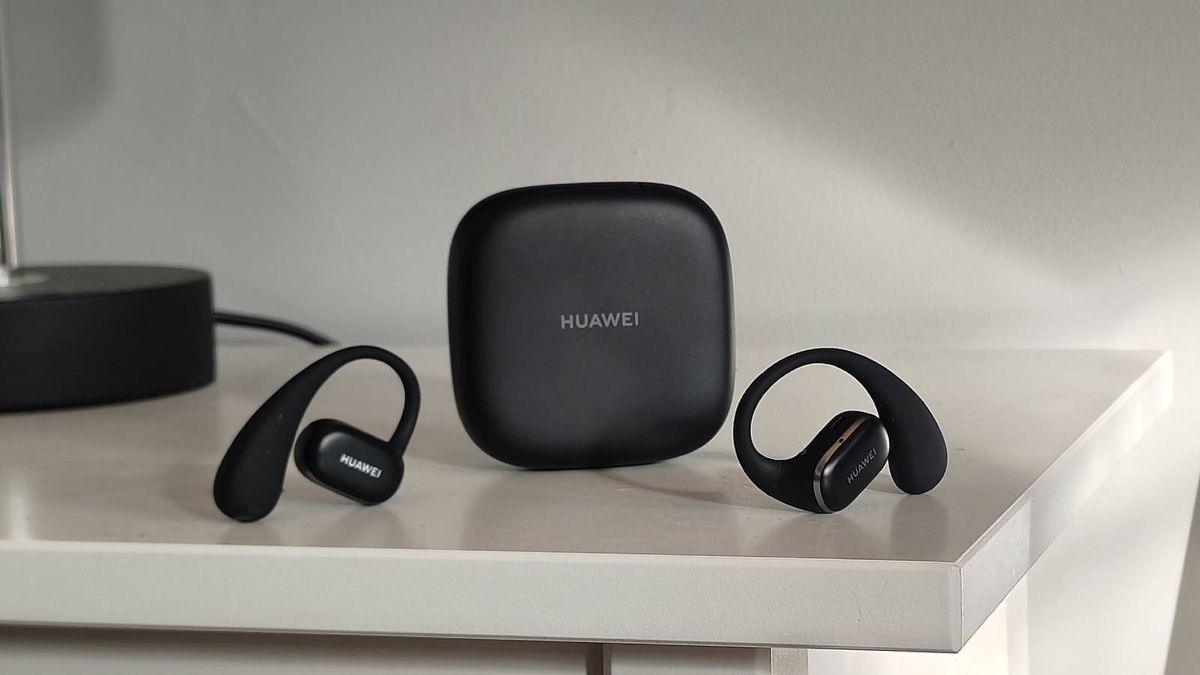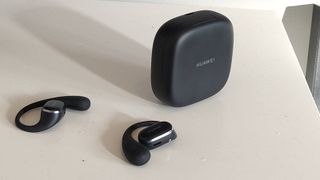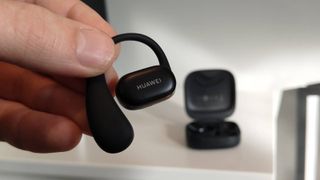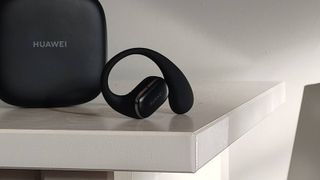
Why you can trust TechRadar We spend hours testing every product or service we review, so you can be sure you’re buying the best. Find out more about how we test.
Huawei FreeArc: One minute review
With audio brands and tech companies announcing open-ear earbuds left, right and center, it was only a matter of time before Chinese giant Huawei got in on the action too.
It was only minutes into the testing for this Huawei FreeArc review, though, that I understood these to be some of the best open-ear buds on the market right now. Huawei’s onto something here!
The reason for this is simple: as of their release, the Huawei FreeArc are the best-sounding examples of this form factor, and that’s a really impressive selling point given how earbuds like this work.
For those who aren’t familiar, open-ear headphones like these dangle the earbud over your eardrum, instead of plonking it straight in there; this means you can still hear sounds beyond your music. Useful for people in busy areas or who need to hear announcements, but less useful for audiophiles as having a bud centimeters from your ear can spell doom for well-tuned music.
Not with the FreeArc, though. Music has an impressive soundstage, sounds delicately tuned and maintains bristling energy. The best compliment I can give to Huawei is that I often forgot I was listening to open-ears.
Two enthusiastic thumbs up in the audio department, then, although the FreeArc do struggle just a little in a few other departments. The battery life is one, with the 23-hour lasting power of the case in particular an area that might dissuade certain buyers.
If you’ve got an Android phone, you’ll also find the app install process an absolute pain, as you have to side-load multiple apps through APKs. The process is only suitable for technophiles, or someone who can rope in a tech-savvy relative or friend to help.
OK so great-sounding, just slightly annoying to set up? Yes, but we’re missing the big draw. Huawei has priced these buds to sell, making them some of the most affordable open-ears on the market right now.
You can overlook a few of issues in tech with competitive pricing, and the Huawei FreeArc do benefit from that when you consider their feature set. But purely from a sonic perspective, these are an absolute steal at the price.
Huawei FreeArc review: Specifications
Component | Value |
Water resistant | IP57 |
Battery life | 7 hours (earbuds), 23 hours (total) |
Bluetooth type | Bluetooth 5.2 |
Weight | 8.9g / Charging case: 67g |
Driver | 17mm x 12mm |
Huawei FreeArc review: Price and availability

- Announced in February 2025
- Priced at £99.99 (roughly $130, AU$200)
- Not on sale in Australia or US
The Huawei FreeArc were announced in February 2025, at the same time as a slew of rivals, and went on sale shortly afterwards.
You can pick up the buds for £99.99 (roughly $130, AU$200) so they’re priced competitively against many of these competitors. There’s no US or AU pricing at the time of writing and I don’t expect the buds will go on sale in either region.
There are a few open-ear buds priced around that general area, or a slight amount cheaper, but most competitors cost up to 50% more. So Huawei has put out a really tempting option here.
Huawei FreeArc review: Design

- Mid-sized charging case
- Comfortable and reliable bud fit
- Temperamental touch controls
The Huawei FreeArc comes in a square carry case; it’s not the smallest I’ve ever seen from open-ear buds, but it’s definitely at the smaller end of the spectrum.
The case measures 67.8 x 67.8 x 26.5mm and weighs 67g, and it has basically what you’d expect from an earbuds case: place to lay each bud, a pairing button, and a USB-C port for charging.
The buds themselves weigh 8.9g so they’re not the lightest open-ears I’ve ever tested, but the difference is just a gram or so and they are by no means heavy. Like most open-ears (although not ear-clip/cuff designs – see the Bose Ultra Open), they consist of the main body as well as a sports loop that circles and slips behind the ear, which in the Huawei’s case ends in quite a pronounced teardrop shape.

I found them reliably comfortable and lightweight to wear, and they didn’t shift much during exercises or runs, a problem some other open-ears have. Instead they’re firmly held pretty close to the ear, so you can hear your music well.
The buds’ body supports gesture controls, but I found them a little bit temperamental in picking up my touch. You’re meant to be able to swipe to change volume, double tap to pause or play songs and triple-tap to skip songs, and while the tapping ones worked well, I had to fight with the buds to pick up swiping.
The charging case doesn’t have any protective certification but the earbuds are IP57, which was a pleasant surprise to see given that most rivals are IP54. The ‘5’ in common means that they’re dust resistant and the ‘7’ means that they’re waterpoof up to a depth of 1m for half an hour, whereas most rivals are simply splash-proof. I don’t think this means that you should swim with the buds, but it still means they’re protected from the elements.
You can buy the FreeArcs in black, white or pale green, and as you can tell from the images, my review sample was the former.
- Design score: 4/5
Huawei FreeArc review: Features

- Battery life is 7 hours (only 23 for case)
- App has convoluted installation process
- Could do with extra features
The feature set is the Huawei FreeArc’s Achilles Heel, so let’s get the criticisms out the way upfront.
Firstly, the battery life isn’t amazing. At 7 hours of listening per bud, it’s not awful, though plenty of other buds (especially open-ears) beat it. But worse is the charging case, which only gets you 28 hours of listening, a stat that’s got to be one of the lowest I’ve seen in buds like this.
My biggest issue was that downloading the Huawei AI Life app, to unlock extra features, was an absolute pain (on Android, at least, but on iOS it’s simple). To get it on my Realme phone I had to download Huawei’s AppGallery (as an APK on my browser, as it’s not on the Play Store), which took some convincing on my phone, then use the AppGallery to download the AI Life, convince my phone to let me side-load apps from this app, and then set it up via this app. It’s a lot of faff and it took me about 10 minutes, which is approximately 9 and a half minutes more than this process generally takes me during reviews.

I’m not entirely convinced that the process is worth it either. It mainly lets you find your earbuds if you’ve misplaced them, manage which devices your buds are connected to, and change what the gesture controls do.
The main feature of the app is access to four music presets (default, Elevate for workouts, Treble boost and Voices for boosting vocals). You can also make your own, which gives you access to a 10-band equalizer.
Unlike at least one contemporary rival (that would be the Honor Earbuds Open) there’s no active noise cancellation, no low latency mode and no gimmicky AI feature – yes, I’m looking at the Honor Earbuds Open’s AI translator here. None of these are ubiquitous in open-ears so I can’t detract points for that, but the FreeArc do feel like they’re missing some kind of USP.
- Features score: 4/5
Huawei FreeArc review: Sound performance

- Large 17mm x 12mm drivers
- Impressive sound stage
- Could have done with ANC
The core selling point of the Huawei FreeArc is that they’re the best-sounding open-ear earbuds I’ve tested to date. That’s not the biggest compliment in the world, given that the form factor naturally leads to worse audio (the speaker is dangling away from your ear, of course, and bass clout is usually the first casualty), but I was still impressed with how the FreeArcs sound.
The most palpable and immediately-obvious positive of the FreeArcs’ audio is the soundstage: it’s unprecedented for open-ears, and I was surprised to be able to pick out the strums of guitars and range of piano keys when I was listening.
Music is energetic and exciting, zealous and crisp, and it was a joy to listen to my favorite workout songs and actually hear the details in them. Admittedly, lots of my excitement came from the sheer fact that I could make out individual lines in songs (I hate to harp on, but open-ears generally sound pretty bad), but the Huawei’s do sound great.
Each earbud has a single 17mm x 12mm driver, which is bigger than I can recall seeing in past open-ear headphones, and that might go some way in explaining the quality of the Huawei FreeArc’s sonic performance.
I would have liked to hear a little more bass in the FreeArc, as it ended up sounding just a touch underwhelming during workouts when I wanted a bassy kick. The aforementioned Elevate mode does improve things in terms of bass clout, but it also makes more complex songs sound oddly ‘crunchy’ and distorted, so I stopped using it.
It was almost a shame to listen to such high-quality audio in open-ears – it sounded amazing when listening in quiet environments, but as soon as I left the house or went somewhere busy, the extraneous noise that can’t help but enter your ear makes it hard to appreciate the detail. ANC would be a blessing on these buds.
- Sound performance score: 5/5
Huawei FreeArc review: Value

Given that Huawei tends to release premium products, I was surprised to see the FreeArcs go for £99, which makes them fairly affordable as open-ears go.
They’d be decent value if they only had ‘good’ sound quality, but the fact that they sound great really helps cement the Huawei FreeArc as one of the best-value open-ear buds you can buy right now.
- Value score: 4.5/5
Huawei FreeArc review: scorecard
Category | Comment | Score |
Value | The Huawei FreeArcs offer great sound at an affordable price point. | 4.5/5 |
Design | The FreeArcs are lightweight and comfortable to wear for long bouts. | 4/5 |
Features | A few lackluster or missing features, plus some app installation woes. | 4/5 |
Sound | These are the best-sounding open-ear headphones so far. | 5/5 |
Huawei FreeArc: Should I buy?

Buy them if…
Don’t buy them if…
Also consider
Component | Huawei FreeArc | Honor Earbuds Open | OpenRock Pro |
Water resistant | IP57 | IP54 | IPX4 |
Battery life | 7 hours (earbuds), 28 hours (total) | 6 hours (earbuds), 40 hours (total) | 19 hours (earbuds), 46 hours (total) |
Bluetooth type | Bluetooth 5.2 | Bluetooth 5.2 | Bluetooth 5.2 |
Weight | 8.9g / Charging case: 67g | 7.9g / Charging case: 52.5g | 13g / Charging case: 64g |
Driver | 17x12mm | 16mm | 16.2mm |
How I tested
I listened to the Huawei FreeArcs for two weeks before writing this review, and the testing process coincided with that of two rivals: the Honor Earbuds Open and the EarFun Openjump, which helped me better understand all three.
I used the Huawei FreeArc alongside my Android smartphone for most of the review, and also paired them to my Windows laptop at several times. Mostly I listened to music on Spotify but also tested podcasts, games and TV shows. I tested them at home, in the office, on walks around my area and also for various workouts (road cycling, running and gym workouts).
The FreeArcs are the latest of many products I’ve reviewed for TechRadar; I’ve been doing so for over six years and have reviewed headphones, smartphones, tablets and more.
- First reviewed: March 2025
